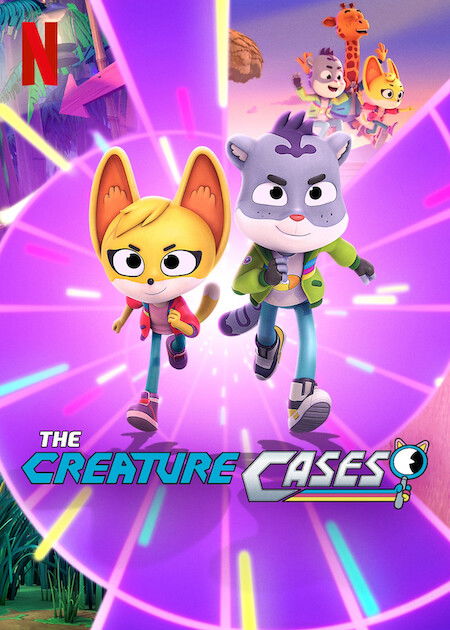“C.L.A.D.E. is on the Case!”

| None | Light | Moderate | Heavy | |
|---|---|---|---|---|
| Language | ||||
| Violence | ||||
| Sex | ||||
| Nudity |
What You Need To Know:
The first three episodes of Season 4 of THE CREATURE CASES present a moral worldview; the characters’ actions imply their morals, demonstrating respect and nicety rather than explicitly discussed. While the series primarily serves as a vehicle for animal facts, there is a subtle implication to respect nature and observe, encouraging curiosity and suggesting a leaning towards environmentalism. However, the focus is mainly on the facts and how that information is helpful in the plot. The episodes are entertaining, fun, and engaging, allowing children to learn more about animals from around the world. The cases are simple and suitable for a young audience.
Content:
A moral worldview, where morals are implied by the actions of the characters showing respect or nicety, not discussed per say but more so implied. The show’s setting is a more technologically advanced world, with simplistic plot lines and settings. The lessons carefully skirt any direct mention of moral lessons, at least in these episodes. While the series serves mainly as a vehicle for animal facts, there is a light implication to respect nature and observe while encouraging curiosity, suggesting a leaning towards environmentalism – however, this is not overtly stated, instead focusing mainly on the facts and how that information is useful to the plot. The characters are enthusiastic about their missions and solving them as a team where everyone has something to contribute to solving the mystery or at least participate in the action;
No foul language;
Light cartoon violence, the characters tend to be reckless in the action scenes with instances of characters tripping, falling, being chased or knocked into by another character. In episode 1, Sam falls out of a tree when both agents are swing from ropes quickly up and through the trees; in episode 2, the agents are chased off several cliffs by a giant snowball; and in episode 3, there are several instances in a hoverboard chase where characters falling off and almost being hit by others on hoverboards. Sam does fall off his hoverboard and crashes, as well as characters hanging from and falling out of trees;
No sex;
No nudity;
No alcohol use;
None;
One suggestion of gambling in episode 2, where the bees with gangster-like personalities are playing cards, but no money is visible. The characters are often reckless in action scenes, doing stunts that would be considered dangerous in real life.
More Detail:
The animation is seamless, colorful, and trendy, with fun, upbeat techno music reminiscent of the 80’s. The characters are delightful and likable, bringing humor throughout the show, especially the side characters such as Wally Bungler – an eccentric, brown flying squirrel who often appears uninvited but is always a valuable asset to the team. Sam is a tidy snow leopard with an English accent who is very into his gizmos and gadgets. Kit, his partner, is a disorganized yellow Kit Fox with an American accent and a vast knowledge of animal species.
The first three episodes of Season 4 of THE CREATURE CASES present a moral worldview; the characters’ actions imply their morals, demonstrating respect and nicety rather than explicitly discussed. The setting of the show is in a more technologically advanced world, with simplistic plot lines and settings. The lessons carefully skirt any direct mention of moral lessons, at least in these episodes. While the series primarily serves as a vehicle for animal facts, there is a subtle implication to respect nature and observe, encouraging curiosity and suggesting a leaning towards environmentalism. However, the focus is mainly on the facts and how that information is helpful in the plot.
Together, the team successfully tackles their cases with enthusiasm and teamwork in mind, which encourages the viewer to cheer them on. As the characters are animals themselves, details reveal real-life traits, such as in Episode 2, where Sam enjoys stepping out of the plane into a blizzard, and in Episode 3, where the Stinkwell skunks, Hans and Harold, enjoy various bad smells throughout the case.
The first three episodes follow a similar story structure. The mysteries are solved using their unique skills as agents and their knowledge of the animals in each case. An action scene usually leads to the solving of the case, often with reckless stunts by the agents and other characters. When the case is solved, a final scene between the agents reflects the lesson, but the focus is mainly on animal information. Every episode closes with the “Mouse Squad’s Fact File” dance segment that restates the facts learned throughout the episode with real-life footage of the animal in discussion.
Episode One of Season 4 begins with Pierre, a yellow garden spider, and artist, who has an unknown, quick-flying thief in the North American jungle steal his web masterpiece. In headquarters, Kit and Sam argue about the role of art, as Kit had created a pottery piece to “simply be enjoyed,” and Sam doesn’t quite understand the use of it. The agents are called to the North American jungle and assure Pierre that they will find out who is stealing his webs.
The first suspects appear as gangster-like buzzing bees portrayed playing cards and drinking lemonade — suggesting gambling, although no money is visible. After using a tracker & their C.L.A.D.E. Claws (wrist units that shoot rope and grappling hooks) to swing through the jungle, they discover the culprit, find out who was stealing the webs, and discover how art can be both beautiful and functional.
Episode Two of Season 4 calls Sam and Kit to the European tundra, where they help an arctic fox mother find her baby in their maze-like den during a blizzard. With the help of Wally Bungler, 3D mapping, paw prints, and a reindeer witness, they track the baby, hoping to find her before predators do. There are many reckless stunts in this episode, especially when Wally trips in the snow and becomes a giant snowball that chases Sam and Kit down the mountain, all of them falling off several cliffs in cartoonish fashion.
Episode Three of Season 4 brings the agents to the South American wetlands where The Stinkwells, Hans and Harold, are blamed for a mystery smell that has taken over the swamp. Called out of lunch by Director Scratch, the chicken director of C.L.A.D.E., Kit expresses her love of stinky cheese that disgusts Sam. Sam uses this to tease Kit, who humorously takes the case as a challenge now to power through and not use the special masks that The Stinkwells’ invented to turn bad smells into good ones.
Using hoverboards and Sam’s wrist scanner, they search for the usual suspects in the swamp, much to the delight of The Stinkwells. There are many references to bad smells, and the skunks do pass “gas” a couple of times as a joke. However, there is nothing lewd beyond the implied smell. In the end, the team’s investigation reveals the culprit’s identity, which ultimately helps someone who is in need.
Overall, the first three episodes of Season 4 THE CREATURE CASES are entertaining, fun, and engaging for children to learn more about animals worldwide. The cases are simple and suitable for a young audience, and the animation is well done, making the story easy to follow.


 - Content:
- Content: 


